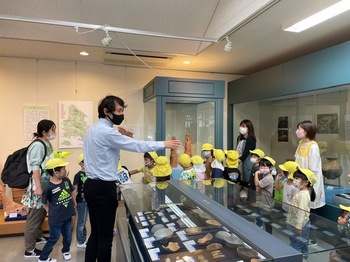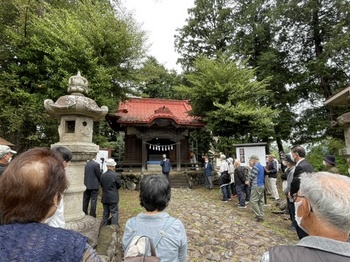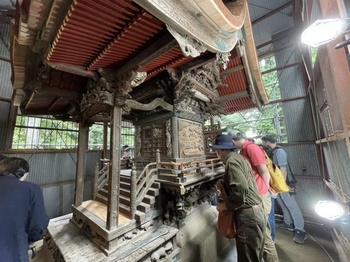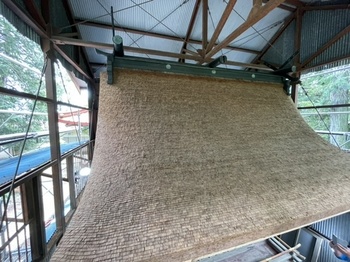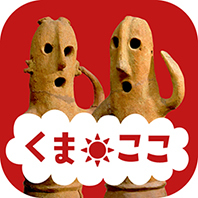きかは便郵124 [きかは便郵]
昔の熊谷地域の絵葉書紹介124回目。今回は「うちわ祭と花火大会」です。
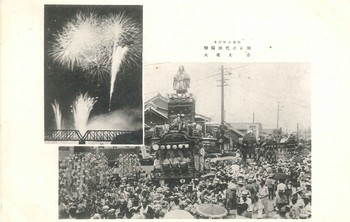
この写真は、熊谷の夏の風物詩となっている「うちわ祭」と「花火大会」の大正末年頃の様子を写したものです。
「うちわ祭」は、毎年7月20日から22日にかけて開催される八坂神社の例大祭です。明治時代に祭に合わせて渋うちわが配られたことからこの名がついたとされています。山車6台・屋台6台がお囃子を鳴らしながら練り歩く巡行を中心としたお祭で、毎年75万人が訪れ、関東一の祇園と称されています。
写真には、中山道を埋め尽くす大勢の人の中に、第壱本町区の山車を先頭に練り歩く山車・屋台が写っています。先頭の花みこしには、「小此木園」の看板が見えます。
今年のうちわ祭りは、新型コロナウイルス感染症対策を講じたうえで、7月20日(水)渡御発輿祭、渡御着輿祭など、7月21日(木)巡行祭など、7月22日(金)行宮祭、年番送りなどが行われます。露店の出店や、熊谷駅前の初叩き合いなどは行いません。
「花火大会」は、熊谷市政施行の翌年にあたる昭和9年8月18日に、「熊谷煙火大会」が、荒川河川敷で開催されたことに始まります。
その後、戦時下に中断され、昭和23年9月11日に戦災からの復興を願って「大熊谷復興煙火大会」が地元露天商組合の主催で開かれました。毎年45万人が訪れる関東でも最大級の、歴史ある花火大会として知られています。
今年の花火大会は、新型コロナウイルス感染防止の観点から、8月13日(土)に、無観客・短時間・分散開催で開催されます。
写真には、大正14年に完成した荒川大橋9連トラス橋の後方に、連発花火が打ち上げられています。

この写真は、熊谷の夏の風物詩となっている「うちわ祭」と「花火大会」の大正末年頃の様子を写したものです。
「うちわ祭」は、毎年7月20日から22日にかけて開催される八坂神社の例大祭です。明治時代に祭に合わせて渋うちわが配られたことからこの名がついたとされています。山車6台・屋台6台がお囃子を鳴らしながら練り歩く巡行を中心としたお祭で、毎年75万人が訪れ、関東一の祇園と称されています。
写真には、中山道を埋め尽くす大勢の人の中に、第壱本町区の山車を先頭に練り歩く山車・屋台が写っています。先頭の花みこしには、「小此木園」の看板が見えます。
今年のうちわ祭りは、新型コロナウイルス感染症対策を講じたうえで、7月20日(水)渡御発輿祭、渡御着輿祭など、7月21日(木)巡行祭など、7月22日(金)行宮祭、年番送りなどが行われます。露店の出店や、熊谷駅前の初叩き合いなどは行いません。
「花火大会」は、熊谷市政施行の翌年にあたる昭和9年8月18日に、「熊谷煙火大会」が、荒川河川敷で開催されたことに始まります。
その後、戦時下に中断され、昭和23年9月11日に戦災からの復興を願って「大熊谷復興煙火大会」が地元露天商組合の主催で開かれました。毎年45万人が訪れる関東でも最大級の、歴史ある花火大会として知られています。
今年の花火大会は、新型コロナウイルス感染防止の観点から、8月13日(土)に、無観客・短時間・分散開催で開催されます。
写真には、大正14年に完成した荒川大橋9連トラス橋の後方に、連発花火が打ち上げられています。
令和3年度「地域観光資源の多言語解説整備支援事業」ー熊谷うちわ祭り 山車概要ー [その他]
Festival Float Overview
山車概要
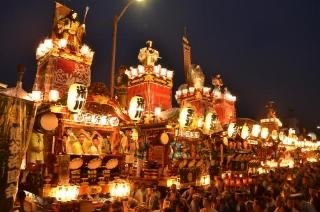
Twelve decorated dashi and yatai floats take part in the Kumagaya Uchiwa Festival, each representing a different neighborhood. Seven of the floats are dashi, tall floats that can reach a height of 9 meters and are decorated with models of ancient deities and historical figures. The other five floats are called yatai. All are ornately carved and decorated to resemble shrines, with a platform at the front for musicians playing drums, cymbals, and flutes. The dashi and yatai are pulled through the streets of Kumagaya on each of the three days of the festival and are lined up in the festival square in front of Kumagaya Station in the evenings.
Until the late nineteenth century, the Kumagaya Uchiwa Festival consisted of Shinto ceremonies and a portable shrine procession. During the Meiji era (1868–1912), Kumagaya was a center of commerce in the region, with a thriving silk industry. In the late nineteenth century, the Daini Honcho-ku neighborhood purchased a lavish festival float from Tokyo to use in the annual festival. Other neighborhoods began to build their own dashi and yatai for the event, and a friendly rivalry developed over the years, adding to the excitement of the occasion.
※この英語解説文は観光庁の地域観光資源の多言語解説整備支援事業で作成しました。

Twelve decorated dashi and yatai floats take part in the Kumagaya Uchiwa Festival, each representing a different neighborhood. Seven of the floats are dashi, tall floats that can reach a height of 9 meters and are decorated with models of ancient deities and historical figures. The other five floats are called yatai. All are ornately carved and decorated to resemble shrines, with a platform at the front for musicians playing drums, cymbals, and flutes. The dashi and yatai are pulled through the streets of Kumagaya on each of the three days of the festival and are lined up in the festival square in front of Kumagaya Station in the evenings.
Until the late nineteenth century, the Kumagaya Uchiwa Festival consisted of Shinto ceremonies and a portable shrine procession. During the Meiji era (1868–1912), Kumagaya was a center of commerce in the region, with a thriving silk industry. In the late nineteenth century, the Daini Honcho-ku neighborhood purchased a lavish festival float from Tokyo to use in the annual festival. Other neighborhoods began to build their own dashi and yatai for the event, and a friendly rivalry developed over the years, adding to the excitement of the occasion.
※この英語解説文は観光庁の地域観光資源の多言語解説整備支援事業で作成しました。
椎雀会由来之碑 [句碑・歌碑]
市内善ケ島の龍泉寺に建てられている椎雀会由来之碑を紹介します。
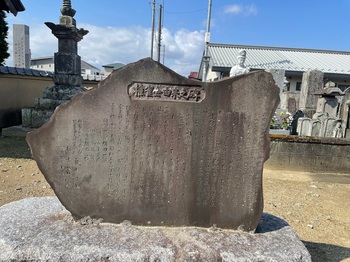
椎雀会とは、善ケ島出身の歌人可良久(羽鳥又左衛門:1775-1847)を顕彰するために昭和22年に発足したもので、昭和58年に、可良久の句「わらじなき 仁王にさすや 冬の月」(歓喜院の仁王像を詠んだもの)を刻み「永く法林の青苔を冠するを祈って」本碑が造立されました。撰文・書は大山雄堂です。
可良久は、善ケ島に生まれ、天明6年下奈良の吉田市衛門宗敬に預けられ、江戸に春秋庵加舎白雄(1738-1791)の門をたたき、俳句の道を学びました。白雄死後、各地を行脚して見聞を広め、江戸に帰った後は、千住の秋香庵建部巣兆(1761-1814)に入門しますが、実家の跡継ぎのため寛政12年に帰郷します。文政12年名主となり、文政5年には植村家の御勝手賄役となり、財政の立て直しに尽くし、苗字御免となります。江戸に赴くことが多くなり、文人・墨客との交流を深め、天保6年名主役を子文次郎に譲り、屋敷内にある椎の木の傍に居(椎雀亭)を構え、椎庵と号し俳句に専念しました。弘化4年(1847)73歳で没しています。
龍泉寺本堂には、亀田鵬斉(書家:1752-1826)書、春木南湖(文人画家:1759-1839)画賛の「椎雀亭記」が掲げられています。

椎雀会とは、善ケ島出身の歌人可良久(羽鳥又左衛門:1775-1847)を顕彰するために昭和22年に発足したもので、昭和58年に、可良久の句「わらじなき 仁王にさすや 冬の月」(歓喜院の仁王像を詠んだもの)を刻み「永く法林の青苔を冠するを祈って」本碑が造立されました。撰文・書は大山雄堂です。
可良久は、善ケ島に生まれ、天明6年下奈良の吉田市衛門宗敬に預けられ、江戸に春秋庵加舎白雄(1738-1791)の門をたたき、俳句の道を学びました。白雄死後、各地を行脚して見聞を広め、江戸に帰った後は、千住の秋香庵建部巣兆(1761-1814)に入門しますが、実家の跡継ぎのため寛政12年に帰郷します。文政12年名主となり、文政5年には植村家の御勝手賄役となり、財政の立て直しに尽くし、苗字御免となります。江戸に赴くことが多くなり、文人・墨客との交流を深め、天保6年名主役を子文次郎に譲り、屋敷内にある椎の木の傍に居(椎雀亭)を構え、椎庵と号し俳句に専念しました。弘化4年(1847)73歳で没しています。
龍泉寺本堂には、亀田鵬斉(書家:1752-1826)書、春木南湖(文人画家:1759-1839)画賛の「椎雀亭記」が掲げられています。
令和3年度「地域観光資源の多言語解説整備支援事業」ー熊谷うちわ祭り 彌生町区(山車)ー [その他]
Yayoicho-ku Yatai Festival Float
弥生町区(屋台)
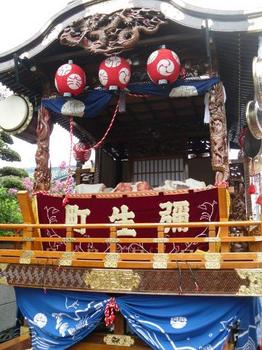
The oldest complete yatai float was built by the residents of the Yayoicho-ku neighborhood in 1924. It is one of five yatai floats (smaller than dashi floats) used in the Kumagaya Uchiwa Festival, and the oldest surviving complete example. The detailed carvings around the sides of the float depict auspicious animals such as turtles, cranes, and peacocks, as well as scenes from Japan’s creation legends. At the front of the float, there is a dragon under the gable in an elaborately curved pose, while two dragons climb the front support pillars. Above the gable, a carving depicts Susanoo no Mikoto, deity of the sea and storms, saving a princess from a snake-headed monster. The float is a Tangible Folk Cultural Property of Kumagaya.
※この英語解説文は観光庁の地域観光資源の多言語解説整備支援事業で作成しました。

The oldest complete yatai float was built by the residents of the Yayoicho-ku neighborhood in 1924. It is one of five yatai floats (smaller than dashi floats) used in the Kumagaya Uchiwa Festival, and the oldest surviving complete example. The detailed carvings around the sides of the float depict auspicious animals such as turtles, cranes, and peacocks, as well as scenes from Japan’s creation legends. At the front of the float, there is a dragon under the gable in an elaborately curved pose, while two dragons climb the front support pillars. Above the gable, a carving depicts Susanoo no Mikoto, deity of the sea and storms, saving a princess from a snake-headed monster. The float is a Tangible Folk Cultural Property of Kumagaya.
※この英語解説文は観光庁の地域観光資源の多言語解説整備支援事業で作成しました。
令和3年度「地域観光資源の多言語解説整備支援事業」ー熊谷うちわ祭り 第二本町区(山車)ー [その他]
Daini Honcho-ku Festival Float
第二本町区(山車)
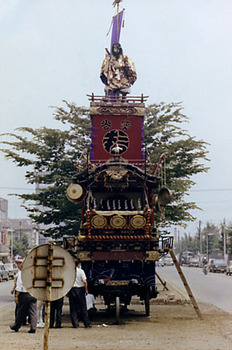
The oldest float in the festival is a tall dashi that was purchased from Tokyo by members of Daini Honcho-ku neighborhood in 1891 and pulled to Kumagaya by oxen. The purchase price was reported to be 500 yen making it about the same price as a luxury sports car in today’s money. The float is believed to have been made during the late Edo period (1603–1867) and was used in the annual festival at Tokyo’s Kanda Myojin Shrine before it was brought to Kumagaya.
The float is decorated with gilded panels carved with dragons, birds, and cloud motifs, and is topped with a figure of the deity Ame no Tajikarao. According to legend, when the sun goddess Amaterasu hid herself in a cave, Ame no Tajikarao threw aside the rock in front of the cave and pulled her out, returning light to the world. He is known as the deity of strength and the protector of agriculture. The float is a Tangible Folk Cultural Property of Kumagaya.
※この英語解説文は観光庁の地域観光資源の多言語解説整備支援事業で作成しました。

The oldest float in the festival is a tall dashi that was purchased from Tokyo by members of Daini Honcho-ku neighborhood in 1891 and pulled to Kumagaya by oxen. The purchase price was reported to be 500 yen making it about the same price as a luxury sports car in today’s money. The float is believed to have been made during the late Edo period (1603–1867) and was used in the annual festival at Tokyo’s Kanda Myojin Shrine before it was brought to Kumagaya.
The float is decorated with gilded panels carved with dragons, birds, and cloud motifs, and is topped with a figure of the deity Ame no Tajikarao. According to legend, when the sun goddess Amaterasu hid herself in a cave, Ame no Tajikarao threw aside the rock in front of the cave and pulled her out, returning light to the world. He is known as the deity of strength and the protector of agriculture. The float is a Tangible Folk Cultural Property of Kumagaya.
※この英語解説文は観光庁の地域観光資源の多言語解説整備支援事業で作成しました。
好奇心から始まる旅 [普及事業]
きかは便郵123 [きかは便郵]
昔の熊谷地域の絵葉書紹介123回目。今回は「熊谷停車場」です。
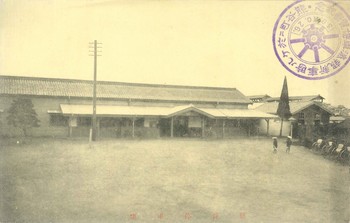
この写真は、「熊谷停車場」を写したものです。瓦葺平屋の建物と右手奥にホームに行くための跨線人道橋が見えます。停車場外の広場には、人力車が3台停められており、客待ちの車夫が2人写っています。
「停車場」とは、駅よりも意味が広く、操車場や信号場などの行き違いや待ち合わせなどを含めた列車が発着する場所を指します。
「熊谷停車場」は、明治16年(1883)7月28日上野‐熊谷駅間の日本鉄道第1期線(現在の高崎線)の駅として開業したものです。
右上には、「熊谷町ニ於ケル時事新報汽車博覧会記念39.10.26」のスタンプが押されています。
汽車博覧会は、明治39年9月から大阪時事新報社が主催した汽車を使用した博覧会で、主要駅に汽車を停車させ、丸善や高島屋・三越等がその中で展示販売を行いました。当時としては新しい試みで、博覧会とは言えない規模のものでした。
現在でも、この停車場の名を冠した「埼玉県道91号熊谷停車場線」の県道名が残っています。この県道は、熊谷駅北口ロータリーと国道17号線までの260m区間で、「熊谷駅前通り」とも言われていましたが、2019年ラグビーワールドカップ日本大会の本市での開催を記念して、愛称「ラグビーロード」に変更となっています。

この写真は、「熊谷停車場」を写したものです。瓦葺平屋の建物と右手奥にホームに行くための跨線人道橋が見えます。停車場外の広場には、人力車が3台停められており、客待ちの車夫が2人写っています。
「停車場」とは、駅よりも意味が広く、操車場や信号場などの行き違いや待ち合わせなどを含めた列車が発着する場所を指します。
「熊谷停車場」は、明治16年(1883)7月28日上野‐熊谷駅間の日本鉄道第1期線(現在の高崎線)の駅として開業したものです。
右上には、「熊谷町ニ於ケル時事新報汽車博覧会記念39.10.26」のスタンプが押されています。
汽車博覧会は、明治39年9月から大阪時事新報社が主催した汽車を使用した博覧会で、主要駅に汽車を停車させ、丸善や高島屋・三越等がその中で展示販売を行いました。当時としては新しい試みで、博覧会とは言えない規模のものでした。
現在でも、この停車場の名を冠した「埼玉県道91号熊谷停車場線」の県道名が残っています。この県道は、熊谷駅北口ロータリーと国道17号線までの260m区間で、「熊谷駅前通り」とも言われていましたが、2019年ラグビーワールドカップ日本大会の本市での開催を記念して、愛称「ラグビーロード」に変更となっています。
令和3年度「地域観光資源の多言語解説整備支援事業」ー熊谷うちわ祭り 第一本町区(山車)ー [その他]
Daiichi Honcho-ku Festival Float
第一本町区 (山車)
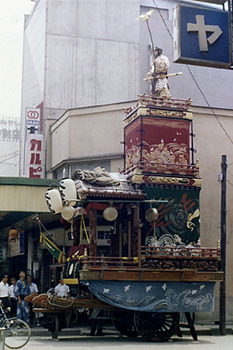
The second oldest dashi float was inspired by the friendly rivalry between neighborhoods. After Kumagaya’s Daini Honcho-ku neighborhood purchased the first festival float from Tokyo in 1891, the residents of the Daiichi Honcho-ku neighborhood built their own. A model of Japan’s first emperor Jimmu, said to be a descendant of the sun goddess Amaterasu, stands on top of the float. He is depicted holding a gilded staff with a crow perched on top. According to legend, the emperor was guided through the mountains from Kumano, in present-day Wakayama Prefecture, to Yamato, in present-day Nara Prefecture, by a three-legged crow.
The dashi is decorated with carved dragons and mythical birds across the front lintel and supporting pillars, and lions along the balustrades on the sides and back of the float. The rear section of the float is covered with a green tapestry depicting a battle between a dragon and a tiger, richly embroidered in gold thread. This common trope in traditional Japanese art symbolizes the balance of forces in the universe. The float was built in 1898 and is a Tangible Folk Cultural Property of Kumagaya.
※この英語解説文は観光庁の地域観光資源の多言語解説整備支援事業で作成しました。

The second oldest dashi float was inspired by the friendly rivalry between neighborhoods. After Kumagaya’s Daini Honcho-ku neighborhood purchased the first festival float from Tokyo in 1891, the residents of the Daiichi Honcho-ku neighborhood built their own. A model of Japan’s first emperor Jimmu, said to be a descendant of the sun goddess Amaterasu, stands on top of the float. He is depicted holding a gilded staff with a crow perched on top. According to legend, the emperor was guided through the mountains from Kumano, in present-day Wakayama Prefecture, to Yamato, in present-day Nara Prefecture, by a three-legged crow.
The dashi is decorated with carved dragons and mythical birds across the front lintel and supporting pillars, and lions along the balustrades on the sides and back of the float. The rear section of the float is covered with a green tapestry depicting a battle between a dragon and a tiger, richly embroidered in gold thread. This common trope in traditional Japanese art symbolizes the balance of forces in the universe. The float was built in 1898 and is a Tangible Folk Cultural Property of Kumagaya.
※この英語解説文は観光庁の地域観光資源の多言語解説整備支援事業で作成しました。
埼玉県指定有形文化財 「諏訪神社本殿」保存修理事業終了記念 特別公開 [建造物]
令和3年度「地域観光資源の多言語解説整備支援事業」ー妻沼聖天山歓喜院 全体概要ー [その他]
Menuma Shodenzan Temple Overview
妻沼聖天山歓喜院全体概要
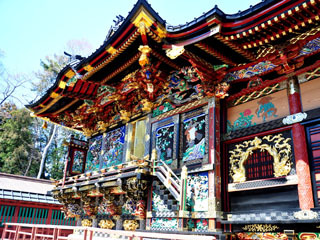
The grounds of Menuma Shodenzan Temple include a lavishly decorated main hall, and a stroll garden with Buddhist statuary and a pagoda. The main hall, the Shodendo, exemplifies the decorative temple architecture of the mid-Edo period (1603–1867), and is often compared to Nikko Toshogu Shrine in Tochigi Prefecture for its elaborate carvings. The main hall was built in 1760 and venerates Shoden (or Kangiten), the deity of joy, conjugal harmony, and longevity. Menuma Shodenzan Temple was founded in 1179 by Saito Sanemori (1111–1183), a legendary samurai and military commander.
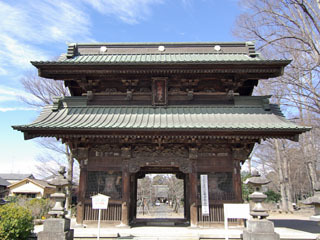
The gateway to the temple
The Kisomon Gate is the main entrance to the temple. It has an unusual roof with three overlapping gables, which protect the elaborate decorations carved on the eaves and lintels beneath from the elements. The detailed, three-dimensional carvings include two guardian Nitenno figures (Heavenly Kings) flanking the Kisomon Gate.
The main approach leads to the Shodendo, the main hall and the spiritual heart of the temple. The exterior of the Shodendo is adorned with colorful carvings depicting allegories, Buddhist teachings, and images from classical Chinese culture. The Shodendo is designated a National Treasure.
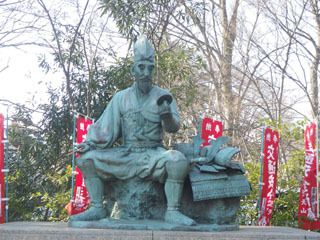
A valiant warrior
A statue of temple founder Saito Sanemori (1111–1183) depicts him in his seventies holding a mirror and an ink brush, poised to color his gray hair black. He was determined not to be underestimated by younger warriors and is said to have dyed his hair black before fighting in the Battle of Shinohara (1183), where he met his demise. Sanemori was the governor of present-day northern Saitama and served as a retainer to the powerful Heike family, who fought for control of Japan in the twelfth century.

A garden of peace and harmony
The stroll garden behind the main temple buildings has a winding path that takes visitors past a stream and waterfall, as well as Buddhist statuary. The two-story Heiwa no To Peace Pagoda in the garden commemorates the people who lost their lives in World War II and was built to mark the ratification of the San Francisco Peace Treaty of 1951. Two trees known as the Meoto no Ki (wedded trees) grow close together with their roots entwined and are believed to symbolize a strong and happy relationship.
Menuma Shodenzan Temple is in the center of Menuma, an area in the north of Kumagaya, in Saitama Prefecture. Many of the temple structures were built with donations from the local community.
※この英語解説文は観光庁の地域観光資源の多言語解説整備支援事業で作成しました。

The grounds of Menuma Shodenzan Temple include a lavishly decorated main hall, and a stroll garden with Buddhist statuary and a pagoda. The main hall, the Shodendo, exemplifies the decorative temple architecture of the mid-Edo period (1603–1867), and is often compared to Nikko Toshogu Shrine in Tochigi Prefecture for its elaborate carvings. The main hall was built in 1760 and venerates Shoden (or Kangiten), the deity of joy, conjugal harmony, and longevity. Menuma Shodenzan Temple was founded in 1179 by Saito Sanemori (1111–1183), a legendary samurai and military commander.

The gateway to the temple
The Kisomon Gate is the main entrance to the temple. It has an unusual roof with three overlapping gables, which protect the elaborate decorations carved on the eaves and lintels beneath from the elements. The detailed, three-dimensional carvings include two guardian Nitenno figures (Heavenly Kings) flanking the Kisomon Gate.
The main approach leads to the Shodendo, the main hall and the spiritual heart of the temple. The exterior of the Shodendo is adorned with colorful carvings depicting allegories, Buddhist teachings, and images from classical Chinese culture. The Shodendo is designated a National Treasure.

A valiant warrior
A statue of temple founder Saito Sanemori (1111–1183) depicts him in his seventies holding a mirror and an ink brush, poised to color his gray hair black. He was determined not to be underestimated by younger warriors and is said to have dyed his hair black before fighting in the Battle of Shinohara (1183), where he met his demise. Sanemori was the governor of present-day northern Saitama and served as a retainer to the powerful Heike family, who fought for control of Japan in the twelfth century.

A garden of peace and harmony
The stroll garden behind the main temple buildings has a winding path that takes visitors past a stream and waterfall, as well as Buddhist statuary. The two-story Heiwa no To Peace Pagoda in the garden commemorates the people who lost their lives in World War II and was built to mark the ratification of the San Francisco Peace Treaty of 1951. Two trees known as the Meoto no Ki (wedded trees) grow close together with their roots entwined and are believed to symbolize a strong and happy relationship.
Menuma Shodenzan Temple is in the center of Menuma, an area in the north of Kumagaya, in Saitama Prefecture. Many of the temple structures were built with donations from the local community.
※この英語解説文は観光庁の地域観光資源の多言語解説整備支援事業で作成しました。
